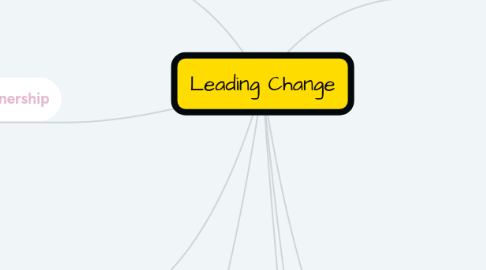
1. Reasons to Engage
1.1. The change will make lives better
1.2. Will change the organization for the better
1.3. Their efforts contribute to the change
2. Give Them Ownership
2.1. Increases sense of control
2.2. People will follow what they create
2.3. Identifies barriers to change
2.4. Increases quality of work
3. Enable the Change
3.1. Set Expectations
3.2. Provide training
3.3. Allow practice
3.4. Recognizes people's accomplishments
3.4.1. Rewards those who earned it
3.4.2. Gives credit where credit is due
3.5. Leaders change first!
3.5.1. Don't expect team to change if you can't adjust yourself.
4. Formulating Your Message
4.1. Behavior +Feelings +Effects +Needs Clear Communication
4.2. Behavior/Situation
4.2.1. What has happened?
4.2.2. What is the change that needs to be responded to?
4.2.3. Example from book:
4.2.3.1. "Since we've started using the new application, absenteeism has increased significantly. Let's discuss the situation to see if we can discover the reasons."
5. Communication
5.1. Explain reasons for the change
5.1.1. Clearly tell people the 'whys'.
5.1.2. Give as much info as you can.
5.1.3. Keep everyone informed of new developments.
5.1.4. Speak on how this change will effect the org in a positive way.
5.2. Talk to people in person
5.2.1. Voicemails and emails are good for following up after one one meetings.
5.3. Tell people the truth
5.3.1. The more informed the better
5.3.2. You don't have to know all the answers
5.3.3. Any questions your team has - do your best to find them answers.
5.3.4. Schedule meetings once knowledge has been gained
5.4. Express your feelings
5.4.1. People want to know how you're feelings.
5.4.2. They will feel acknowledged and understood.
5.4.3. Often your feelings are reflections of theirs
5.4.4. Solidarity!
5.5. Take first steps
5.5.1. Just getting started could be the first obstacle.
6. Planning and Leading a Change Meeting
6.1. Review need for change
6.2. Describe details of change
6.3. Explain how change will effect team
6.4. Ask for questions about change
6.4.1. Invite participation
6.5. Listen to feelings, respond emphatically
6.6. Express feelings if appropriate (as stated in communication)
6.7. Ask for help and support in implementing change
7. Vision of Change
7.1. Develop strategies
7.2. K.I.S.S.
7.2.1. Keep it simple and explain in layman's terms
